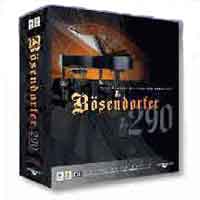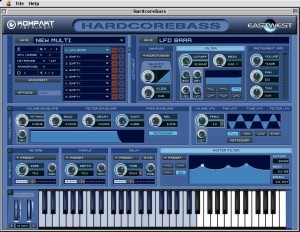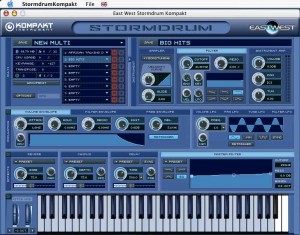Last Updated on December 22, 2015 by
East-West and Native Instruments combine talents to produce a range of New Generation instruments. We sample three of the latest…
Information

Product: Hardcore Bass
Price: $189.95 £129.99
Product: Bösendorfer 290
Price: $179.95 £129.99
Product: Stormdrum
Price: $399.95 £249.99
Manufacturer: East West
It can’t be easy thinking up new instruments to make an impact on today’s over-saturated synth and sampler software market. How many radically different ways can you combine analogue synth modules? How many new ways are there to use a collection of samples? Giving the user an infinite number of controls and telling them to ‘get on with it’, may let the vendor promote with ‘as many sounds as your imagination can create’ but most musicians are wise to this and, as we all know, the majority of users tend not to create their own sounds anyway.
So you can imagine the Native Instruments marketing guys and gals pacing around inside a room until one of them has a eureka moment. Users essentially want sounds, good sounds and lots of them, so why not create an instrument with lots of ready-to-go, high-quality sounds based on samples with an interface that let’s users tweak parameters if they want to do so. Even though most users don’t mess much with the presets in an instrument, if the facility is not there they tend not to buy it. Odd, isn’t it!
So welcome to the New Sampling Generation, a collaboration between East-West, Zero-G and Native Instruments. NI provides the sample playback engines by way of customised versions of Kompakt and Intakt and the other companies provide the samples, carefully honed into instruments. The general modus operandi is similar for all three so we’ll look at that first and then at the individual programs.
Big mamma of a machine
All three programs install easily but there are a few caveats. Forget the minimum system requirements. You need a Big Machine to run these programs. Don’t even think of trying to run them unless you have 512Mb RAM minimum and if you want to run other software, too, 1Gb is certainly not unreasonable. East West recommends up to 1.5Gb RAM for the Bösendorfer! There is an option to let you stream samples from the hard disk during playback but, oddly, this has to be downloaded and installed separately; goodness knows why.
All packs include both PC and Mac versions and contain both stand-alone and plug-in versions of the programs. The plug-ins cover all major formats on both platforms although some plug-in formats such as RTAS and Core Audio support may not be currently available but are promised as free downloads so check what you need and availability before buying.
Well plugged in
One of the major pleasures in using instruments such as these is running them as plug-ins within a sequencer. MIDI parts to play the sounds can easily be recorded and you have full MIDI control over many of the instrument parameters, too, via MIDI automation.
Be aware that the Mac version of Stormdrum requires System OS X. The others will run under OS X but activate the Classic Environment. It’s a tough time for Mac users, deciding whether or not to move over to OS X (the purchase of a new Mac is the ideal time to do this!), so make sure that your system can handle whatever instruments you decide to buy and that you’re happy to revert to Classic mode if necessary.
Also, take careful note of the amount of hard disc space you need for storing the samples – over 2Gb for the Bösendorfer, 2.3Gb for the Hardcore Bass and a whopping 4.6Gb for Stormdrum. Add to this the space required for your other music software and for any audio files you create when recording and you’ll soon realise that you may need a larger-than-average hard disk or, better still, a second drive. PC users also take note that you require a DVD drive. Macs have had them for years but they’re still not standard on PCs. Finally, you must register the software within five days or it will stop working. An Internet connection is useful here.
Front ends
The essence of this software is that you get lots of top-notch, high-quality sounds in an easy-to-use, yet tweakable interface. Hardcore Bass and Bösendorfer 290 both use a Kompakt front while Stormdrum includes both Kompakt and Intakt versions. Kompakt is a sampler while Intakt is designed to slice, dice and otherwise manipulate sample loops. It is, of course, particularly suited to the generation of drum loops.
The samples for the programs come in custom NI .nks format. These are large shell files holding within them all the sample data. This is why the hard disk requirements are so large. You cannot install just a selection of sounds to save space – it has to be the Full Monty.
Preaching to the converted
Native Instruments’ custom .nks sample format – yes it’s restrictive, yes it’s a pain and yes we wish we had better access to the samples. NI isn’t the first company to create a holding shell for its samples and it won’t be the last.
Most musicians know that there is a vast range of sample conversion software available, offering to convert between audio formats such as Wave, MP3, AIFF, and between different sampler formats such as Akai, Roland, Emu, Giga, SampleTank, SoundFont and so on.
The .nks format, however, is heavily encrypted and it’s clear that NI does not want you to extract the samples. In fact, it will be interesting to see if any enterprising sample conversion developer comes up with a converter but at least one has said it is not currently pursuing a conversion option. The reason is simple – piracy. Genuine users pay for the irresponsibility of the few.
The Kompakt interface offers all the edit features you’d expect of a sampler, even though the samples are limited to those supplied with the program and you cannot load your own.
There are eight instrument slots, together known as a Mutli, and you can change each instrument’s settings and save the changes as a new Multi. Each instrument in a Multi can be set to its own MIDI channel so you can play eight sounds at once although you probably won’t want to play too many Hardcore Basses together!
You can change an instrument’s key range, transpose it, and route each instrument to a different output on a multi-out audio card. Edit facilities include a range of filters, an envelope generator, four LFOs, and a microtuning section to add a touch of realism when mimicking boy bands or a Posh Spice record.
There is also an effects section featuring Reverb, Chorus, Delay and a Master Filter. They have few controls but work well.
I’m hard, me


The presets are neatly arranged into six bass types and include over 130 bass sounds. They vary from the solid, workaday basses you could use in a wide range of material to OTT bends, and string slides and scrapes that you might use in a wild rock solo just before you take off the bass and smash it into the amp!
Some samples have slides and effects at higher velocity levels. Others, called keyswitch patches, let you play different articulations. All the basses have up and down strokes, some have the up strokes at the top of the keyboard and the down strokes at the bottom. Some alternate between up and down strokes each time you hit a key. The tone of all the patches can be further controlled via the Modulation Wheel and you can quickly and easily create some neat filtered bass effects with this. It’s very empowering to play.
You quickly see how much thought has gone into the creation of these sounds. The only slight misnomer is the title. The basses are not just hardcore and not just played with an amp setting of 11. They would, in fact, fit into virtually every area of modern music including ballads and jazz so to think of them only as meaty, beaty, big and bouncy would be to undervalue them considerably.
Play it again, Sam


One of the most appealing aspects of the Bösendorfer – the real piano, that is – is that it has a larger sound board than many other concert pianos and, with it, a larger dynamic range. The sample recordings have cleverly captured the nuances and subtleties of this magnificent instrument with velocity switch points arranged to create an incredibly realistic performance.
The Bösendorfer 290 also uses the Kompakt interface and you might well ponder on the advisability of messing with such a carefully crafted sampled piano creation. Well, if you don’t want to do it, the producers have done it for you. Many of the presets have had effects applied to them and the results range from the subtle and tasteful to the considerably processed although it’s all been done in the best possible taste. Mostly.
The choice of piano is very much a personal preference. The Bösendorfer is very crisp and bright and rather hard (in a percussive sort of way) in the higher registers. It’s superb fun to play and you may have to tear yourself away in order to try other presets and experiment with the Kompakt settings. If you’re looking for a solid piano sound – with variations – for your sonic arsenal then you simply must try this.
Kickin’ up a storm


The drums were created with a Big Film Score sound in mind and there is a greater variety of drums here than you can shake a, er, drumstick at so to speak. Phoenix reckons it took a year and a half to edit all the drum parts. And you can believe it.
Stormdrum is a program of two parts, one using the Kompakt player and the other using Intakt. The Kompakt section brings together masses of individual drums from numerous drum kits. They are divided into six sections – acoustic drums, electronic drums, large percussion, metal shop, prepared piano, and small percussion. The first two sections are further subdivided: acoustic into individual drums such as cymbals, kicks and snares; and electronic into hits and kits.
Given that you can load eight collections or instruments into a Multi, by setting more than one to the same MIDI channel you can quickly combine them allowing you to create custom drum sets to play from a single keyboard. Of course, you can play up to eight sets of sounds via a sequencer with no restrictions at all.
The big score
Bearing the big film score concept in mind, this collection doesn’t disappoint with a veritable plethora of ethnic percussion to complement and bridge any gaps in more traditional kits.


The collection is inspired and inspirational and although much could be used with traditional pop, rock and dance material (check out the big beats section), it will be the musician looking for something a little more exotic who will really get the most from this collection.
Customs duty
The custom sample format means you cannot use the samples outside the program (although you can use them with NI’s own Kompakt software which gives inveterate tweakers even more tweaking options) so you can’t hive off any favourites to use in your own favourite sampler. Neither can you load and play other samples through the host software. If you think of these programs as stand-alone sound modules it will help resolve the anomaly of a ‘fixed sample’ sampler.
Although these instruments have tremendous tweaking facilities, it’s debatable whether many users will make much use of them. The strength and popularity, therefore, of these programs will rest primarily on their sounds – and based on that criteria they should be very popular indeed! Native Instruments and EastWest have created a new type of instrument using high-quality samples that enable developers to produce unique, innovative and exciting sounds. The platform lends itself to almost infinite development and there are some 20 products already in the line-up.
But no matter how good the sounds are – and they certainly are excellent – the structure limits the instruments to the supplied samples which, in spite of the tweakable interface, inherently limits the sonic variety. So, in a manner of speaking, you’re buying an instrument that can do one thing but do it exceedingly well. There are audio demos of the programs on the East West website so you can hear just how well they do it, too. And then you’ll agree that the franchise is likely to prove very popular and probably as addictive as Rollos – try one and you’ll inevitably want more.
Pros
Superb sounds
Excellent ready-to-play presets
Easy to tweak the sounds
Stand-alone and plug-in versions
Cons
Can’t use samples in other software
Can’t import your own samples
Requires a DVD drive
Macs may need OS X
Summary
These programs offer a superb range of sounds right out the box. Buy them for that and use them quickly before they end up on every record in the world!
8/10
Minimum system requirements
PC: Pentium III/Athlon 500MHz (700MHz recommended), 256Mb RAM (512Mb recommended), Windows 98/Me/XP, DVD drive, much HD space
Mac: G3 500MHz (G4 733MHz recommended), 256Mb RAM (512Mb recommended), Mac OS 9.2/OS X (check program), DVD drive, much HD space
Features
Massive number of quality samples
24-bit sample resolution
Easy-to-use player program
Built-in effects
Lots of presets















